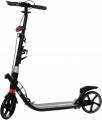Bearing
Bearings that the scooter is equipped with. This paragraph usually indicates not the model/brand, but the class of bearings according to the ABEC standard. Standard options for modern scooters are
ABEC 5,
ABEC 7, and
ABEC 9 ; the higher the number, the higher the quality and accuracy of the part.
There is an opinion that better bearings allow you to accelerate better and go faster. This is partly true, but acceleration and speed are highly dependent on a number of other points — the size and material of the wheels, the weight of the scooter, etc. So models with bearings of the same class can differ markedly in speed characteristics. But what this indicator unambiguously affects is durability and price: high accuracy affects the cost, but such bearings last longer and carry loads better.
Also note that for relatively simple use, ABEC 5 class bearings are quite enough. It makes sense to specifically look for a model with ABEC 7 or ABEC 9 only if you need a scooter for advanced stunts or professional high-speed riding. However, if the selected model has high-quality bearings, it will not be worse from them anyway.
Rear brake
— No brake. The rear wheel is not equipped with a brake. In this case, the braking system may be provided at the front. However, some scooters do not have brakes both at the rear and at the front. The advantage of scooters without a rear brake is that the vehicle will not skid to the side when braking actively when cornering. Scooters without brakes, both front and rear, are mostly the simplest children's models that do not accelerate to a dangerous speed. In this case, braking occurs either by reducing the overrun or by kicking the ground.
— Rim. Rim brakes slow and stop the scooter by pressing the pads against the wheel rim. The rim brake system has an average efficiency. Usually, the scooter stops gently and smoothly. The rim brake is most often installed on the rear wheel of the scooter. The soft brake prevents the vehicle from skidding when braking on turns. Rim brakes are good because they have a simple design. This kind of braking system is easy to maintain. The weak point of rim brakes is a sharp decrease in efficiency when moisture enters the rim.
— Disk. The disc brake on the rear wheel ensures a quick stop of the scooter. This type of braking system is designed more for sports and stunt scooters that often need to quickly decelerate at high speed. But the disc brake can also be found in pleasure, as well as city boards. Disc brakes have a short-stroke friction clutch. Due to the small distance between the pads and the disc, the friction...clutch very quickly comes into contact with the working surface of the brake disc. In this case, the friction clutch is pressed against the disk with a sufficiently large force. The disc brake allows the scooter to stop extremely efficiently. But when using a disc brake on the rear wheel, you should be careful, because when braking hard, especially when cornering, the scooter can skid to the side.
— Drum. The drum brake has above-average efficiency. The drum brake makes the rear wheel massive and heavy. For this reason, scooters with a drum brake system are rarely used as a stunt and sport scooters, but there are exceptions. Urban models are often equipped with a drum-type brake. This type of brake has a closed design. The pads are inside the wheel. Friction linings rub against the inner surface of the rim. Access to the drum brake is closed by a protective cover. Thanks to the closed design, neither moisture nor other blockages get inside the brake drum, which makes the brake operation more reliable and trouble-free. Among the shortcomings can be noted an increase in the dimensions and weight of the wheel and the complexity of maintenance.
— Electric Electric brake is used on electric scooters. The brake system of this type makes the stop extremely soft, slowing down occurs when the speed of the electric motor decreases. The rear location of the electric brake assumes that the electric motor is mounted on the rear wheel. The presence of an electric motor makes the wheel massive, it is difficult to use such scooters for stunts or sports riding, although the engine allows you to quickly pick up and hold speed for a long time. The electric brake system is highly reliable and durable, it does not require maintenance. But if the battery pack on the scooter runs out, the electric brake will not work. For such cases, an additional mechanical (hand or foot) brake is usually provided.
Footspace
This term refers to the useful area of the deck on which you can put your foot. It is size without taking into account the folding mechanism, wheel fastening and other elements that are not intended for the leg.

